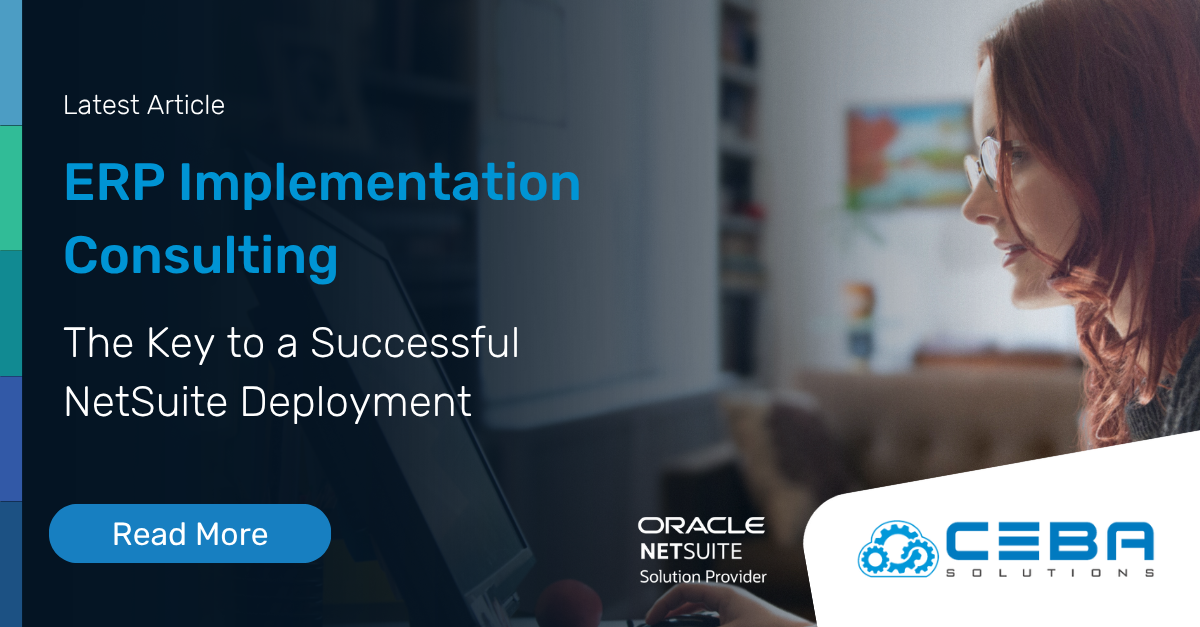
Functionality Deep Dive: Optimizing Your NetSuite Record to Report Process
Functionality Deep Dive: Optimizing Your NetSuite Record to Report Process
NetSuite’s Record to Report (R2R) Process Phases
The Record to Report (R2R) process is a critical component of accounting that involves the collection, processing, and reporting of financial information. There are five distinct phases of the R2R process that are essential for chief financial officers to maintain accurate financial records and produce reliable financial statements.
Phase 1: Day to Day Recording of Transactions
Adhering to a Standard Format
Ensuring that each transaction is recorded in the same format is crucial for maintaining consistency and accuracy in financial records. This can be achieved by following strict guidelines and company-specific policies for transaction recording. By implementing standardized templates for recording different types of transactions, organizations can prevent discrepancies and facilitate the smooth processing of financial information. Standardized templates also make it easier to train new employees on recording transactions and help reduce the likelihood of errors.
Utilizing the Chart of Accounts
NetSuite’s chart of accounts (COA) is an essential tool for categorizing transactions accurately. It is important to use the appropriate chart of accounts for your industry and update it regularly to reflect changes in the company's operations and financial structure. This ensures that all transactions are recorded in the correct accounts, and it simplifies the process of generating financial statements. Training employees on the proper use of the chart of accounts is vital to minimize errors in transaction recording. Regular training sessions can help employees stay up-to-date with any changes in the chart of accounts and reinforce the importance of accurate transaction recording.
Keeping Transaction Documentation
Proper Documentation Maintenance
Maintaining proper documentation for each transaction is vital for accurate financial reporting and ensuring compliance with legal and regulatory requirements. Transaction documents, such as invoices, receipts, and contracts, should be uploaded to NetSuite’s file cabinet and approved by the appropriate team member based on the department that the transaction relates to. Implementing a system for tracking transaction documents and their corresponding financial records can simplify the process of locating specific transactions during audits and reconciliations.
Secure Storage and Easy Retrieval
Organizing and storing transaction documents protects sensitive financial information and ensures compliance with data protection regulations. Both physical and digital storage solutions can be used to safeguard transaction documents, and NetSuite’s document management system should be used to facilitate easy retrieval by team members with the appropriate permissions. Establishing document retention policies ensures that transaction documents are preserved for the required duration, as per legal and regulatory requirements.

Download Your Record to Report Solution Here!
Phase 2: Processing Transactions
Compilation and Indexing
Ensuring Accurate and Complete Totals
Compiling and indexing recorded transactions is necessary to ensure accurate and complete totals in financial records. The NetSuite Accounting Module helps to automate the compilation and indexing process, reducing errors and improving transaction processing efficiency. Regularly reviewing transaction data can also help to identify any missing or duplicate entries, allowing for prompt correction and ensuring the accuracy of financial information in real time reporting.
Updating General Ledger Accounts with Journal Entries
Updating general ledger accounts with transaction data is essential for maintaining up-to-date financial records. Reconciling general ledger accounts with corresponding sub-ledgers and transaction documents can help identify any necessary corrections. Establishing a schedule for regular journal entry updates can streamline the process and ensure that financial records are always current.
Streamlining Transaction Processing
Implementing transaction processing automation, such as AP automation, can help streamline transaction processing and improve efficiency. Evaluating the efficiency and effectiveness of your current transaction processing methods can identify opportunities for improvement that can be supported by NetSuite’s functionality. Training employees on automations is key to ensuring consistent and accurate automated transaction processing, reducing the likelihood of financial records being inaccurate.
Error Detection and Correction
Regular Review of Transaction Data
Reviewing transaction data for errors and inconsistencies daily is best practice when it comes to transaction recording. Implementing a multi-level system of approval can help identify errors early and facilitate prompt correction, preventing errors in financial records. Establishing procedures for employees to report errors in transaction data also encourages accountability throughout your business.
Implementing Internal Controls
Implementing internal controls is vital to minimize the risk of errors during transaction processing. Establishing segregation of duties can prevent unauthorized or fraudulent transactions by ensuring that no single employee has control over all aspects of a transaction. Periodically assessing the effectiveness of internal controls and making improvements as needed can help maintain the integrity of the financial records and reduce the risk of errors or fraud.
Prompt Correction of Errors
Correcting identified errors promptly is essential for maintaining accurate financial records. Documenting the correction process and any adjustments made to financial records can provide a clear audit trail and demonstrate the organization's commitment to accuracy and compliance. Monitoring the frequency and types of errors can also help to shine a light on problems in your transaction recording process and highlight opportunities for changes that can positively impact your reporting processes.
Phase 3: End of Month and End of Period Closing Cycle
General Ledger Locking
End of Accounting Period Close
Locking the general ledger at the end of each accounting period is important to prevent unauthorized changes to the financial records and maintain accurate financial information. Establishing a timeline for locking the general ledger and communicating it to relevant personnel can ensure that all necessary adjustments are made before the ledger is locked, reducing the risk of a closed period needing to be reopened and adjusted.
Adhering to GAAP
Following Generally Accepted Accounting Principles (GAAP) during the closing process is essential for ensuring that financial statements are prepared in accordance with relevant accounting standards and regulations. Applying relevant accounting standards consistently throughout the financial records can help maintain the accuracy and comparability of the company's financial information. Staying updated on changes in accounting standards that may impact the closing process is also crucial for compliance and accurate financial reporting.
Period-End Adjustments
Performing period-end adjustments, such as accruals and deferrals, is necessary to finalize accounts and present a fair view of the company's financial position. Reviewing and approving period-end adjustments before incorporating them into the general ledger can ensure the accuracy of the adjustments and prevent misrepresentation of your financial position.
Closing the Books
Trial Balance Preparation
Preparing a detailed trial balance ensures that debits and credits are equal in the general ledger and that all accounts are in balance. Investigate and resolve any discrepancies in the trial balance before moving forward with the close process. Verifying the accuracy of account balances in the trial balance provides management confidence in the financial information which in turn supports decision making.
Phase 4: Consolidation
Categorizing Transactions
Combining recorded transactions in their appropriate categories is essential to an efficient period close. Grouping transactions based on their nature and impact on the financial statements can help to simplify the consolidation process. Applying consistent classification methods across all departments or subsidiaries can further enhance the reliability of the financial information.
Consolidating Financial Information
Consolidating financial information from various departments or subsidiaries is crucial for providing a comprehensive view of the company's overall financial position and performance. Because NetSuite is a single system of record, all department and subsidiary related transactions can be viewed and consolidated automatically.
Eliminating Intercompany Transactions
Eliminating intercompany transactions and balances during consolidation is essential for presenting a fair view of the consolidated financial position. NetSuite helps users to identify and reconcile complex intercompany transactions between related entities and can ensure proper elimination of intercompany profits and losses, which is crucial for accurate financial reporting. Ensuring that all intercompany transactions are eliminated prevents distortions in your consolidated financial statements.
Validation and Accuracy
Compliance with Accounting Standards
Ensuring that consolidated data complies with relevant accounting standards and regulations is crucial for maintaining the credibility of the company's financial information. Applying consistent accounting policies and practices across all entities within the consolidation can help maintain compliance and ensure accurate financial reporting. Updating consolidation practices as necessary to reflect changes in accounting standards and regulations is vital for staying compliant and maintaining accurate financial records.
Phase 5: Review Final Reports
Generating Final Reports
The final phase of the NetSuite Record to Report (R2R) process involves reviewing the key financial reports that have been generated as a result of the previous phases. These NetSuite CFO reports provide an essential snapshot of the company's financial position and performance, enabling management to make informed decisions and assess the effectiveness of the R2R process. Some of the most important financial reports include:
Balance Sheet
The balance sheet is a statement of a company's financial position at a specific point in time. It shows the company's assets, liabilities, and equity, providing insights into the company's financial stability and solvency. Reviewing the balance sheet can help management understand the company's liquidity, debt levels, and overall financial health.
Income Statement
The income statement, also known as the profit and loss statement, summarizes a company's revenues and expenses over a specified period. It shows the company's net income or loss, which is an essential measure of the company's profitability. Analyzing the income statement can help management identify trends in revenues and expenses and assess the company's operational efficiency.
Cash Flow Statement
The cash flow statement provides information on a company's cash inflows and outflows over a specific period. It is divided into three sections: operating activities, investing activities, and financing activities. Reviewing the cash flow statement can help management understand the company's cash management, identify potential liquidity issues, and evaluate the effectiveness of the company's investment and financing strategies.
Statement of Changes in Equity
This statement shows the changes in a company's equity over a specified period. It includes information on the company's retained earnings, share capital, and other components of equity. Analyzing the statement of changes in equity can help management assess the company's ability to generate shareholder value and understand the sources of changes in equity.
Notes to the Financial Statements
Adding notes to NetSuite reports provide additional information and explanations for items in the financial reports. They often include information on accounting policies, significant estimates and judgments, and details of specific transactions. Reviewing the notes can help management gain a deeper understanding of the company's financial position and performance and ensure compliance with accounting standards and regulations.
By carefully reviewing and analyzing these key financial reports, management can gain valuable insights into the company's financial position and performance, identify areas for improvement and financial planning, and make informed decisions to optimize financial performance. Regular reviews of the financial reports can also help ensure the accuracy and reliability of the R2R and financial processes, contributing to the overall success of the company.
In Summary
In conclusion, the Record to Report (R2R) process is a crucial part of a company's financial management, encompassing the recording, processing, consolidation, and reporting of financial data and transactions. By following a structured and standardized approach to the R2R process as well as the R2R process in BPO , companies can maintain accurate financial records, comply with accounting standards and regulations, and make informed decisions to optimize financial performance. Regularly reviewing and improving the R2R process can help companies stay agile and responsive to changes in their financial environment and continue to grow and succeed. To find out more about our Record to Report services contact us today.










